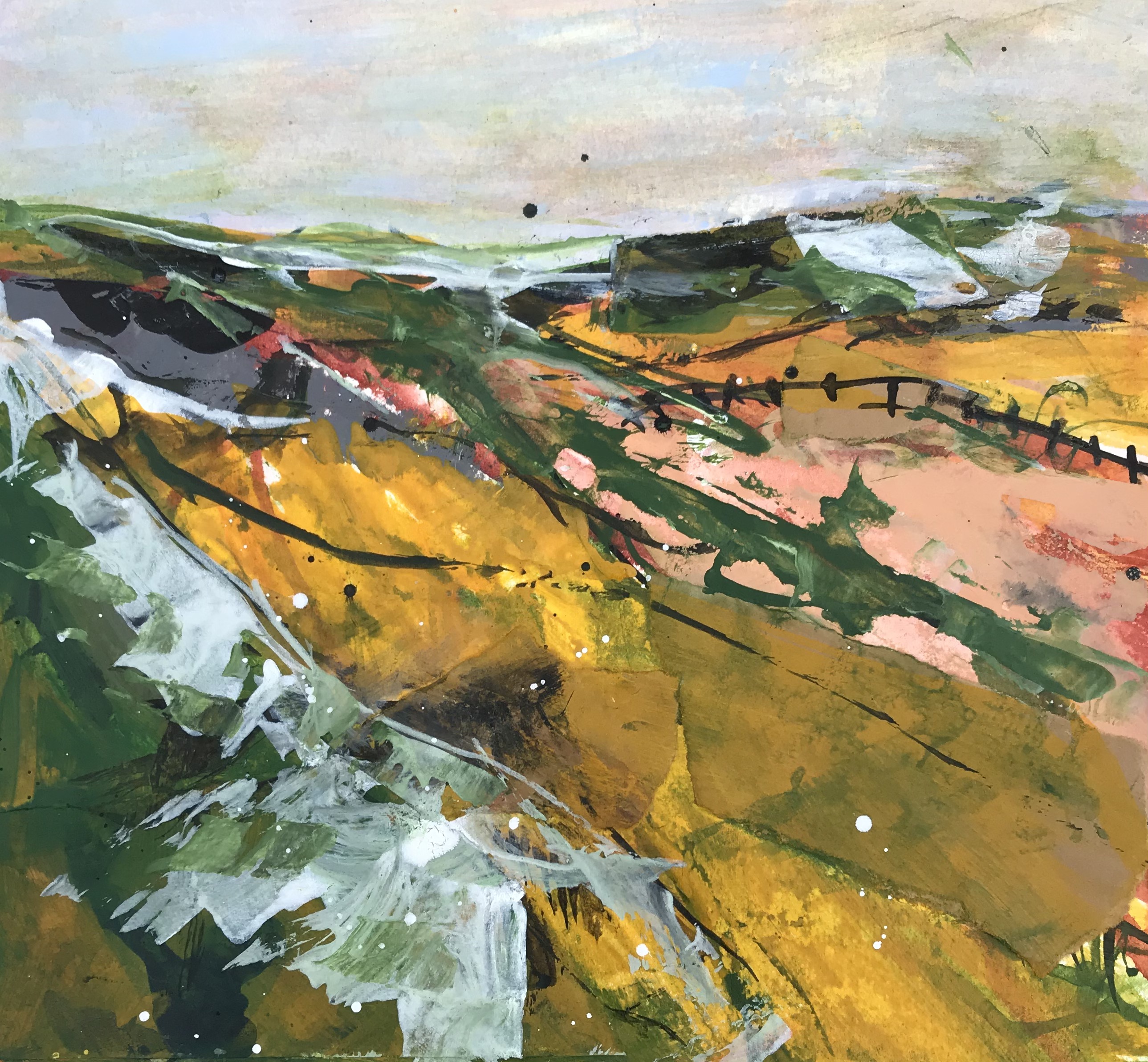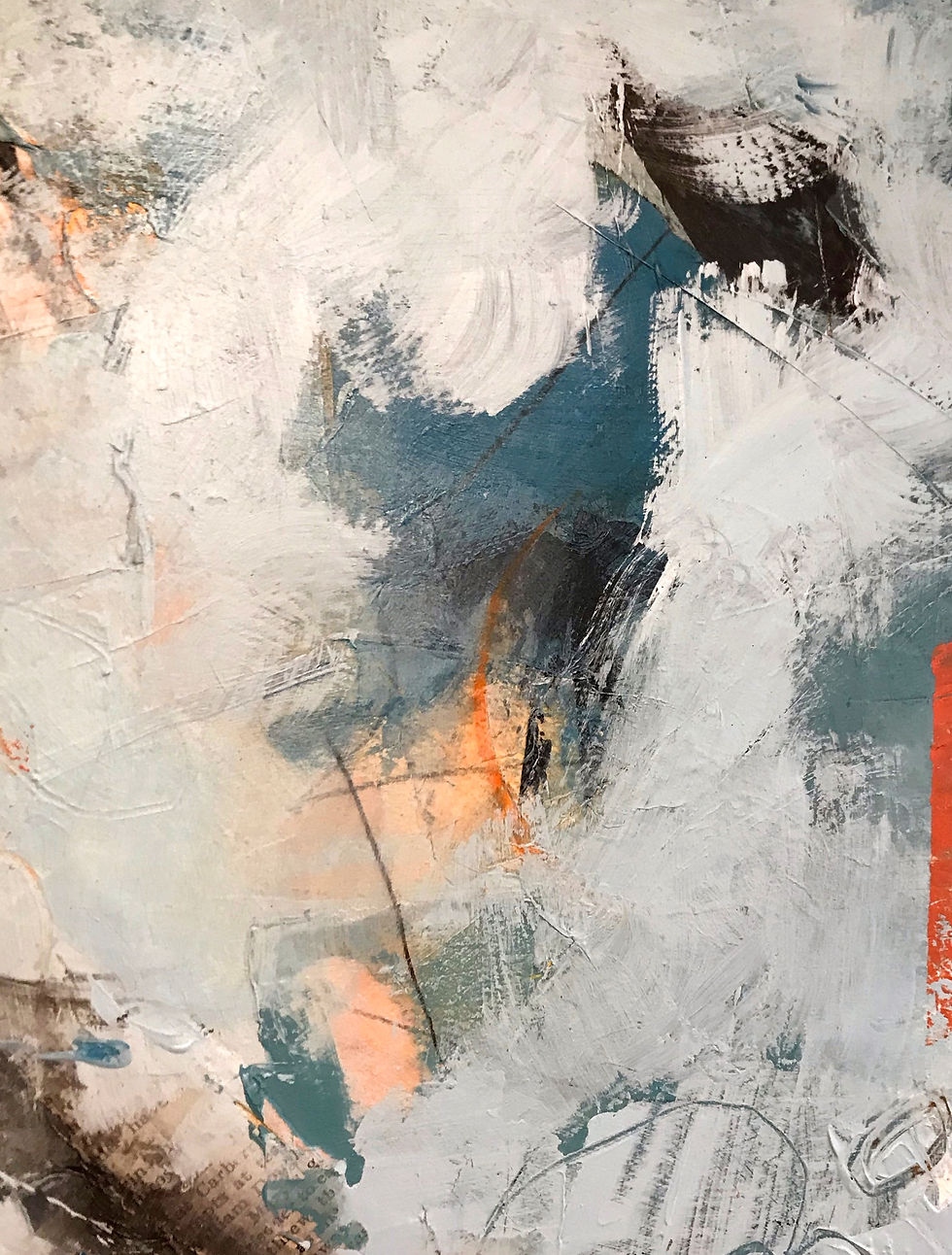Dragons, Inspiration and a Scottie Dog!
- janettesumnerart

- Jan 21, 2024
- 5 min read
Happy New Year!

In my very first Blog post I chatted about the how the colours from the wool I was using for a knitting project started to appear in my paintings! I do find it fascinating that while I’m painting my subconscious mind pushes snippets of information and imagery randomly through into my conscious mind. In my new body of work a dragon has appeared, and it took me quite a while to detect where it had come from!
At Christmas I treated myself to a book by Tracey Williams entitled ‘Adrift’. It’s an intriguing read which explores the unfortunate sinking of sixty-two containers from a cargo ship off the coast of Cornwall, in the south of England. One container was filled with five million pieces of Lego, and most of it was sea themed! Beachcombers started to find Lego across the south west coast, and it has been recorded that pieces have been (and still are) being washed ashore all around the world.
It’s ironic that majority of the Lego was sea themed, and so among the beach finds are tiny scuba-tanks, flippers, life rafts, octopuses, cutlasses and sea-dragons! This is what peaked my interest in the book, that tidelines and rock pools around the world were holding these treasures. However, there were only a small number of green sea-dragons, as the consignment of these were mostly black. It became a beachcombers mission to find a green one, and many have been found, but to this day there are still some elusive green sea-dragons out there.
I’ve digressed a bit, but I do love beach finds and Lego, and this book fired my imagination- so much so the dragon appeared in my work!
I’ve also just finished reading Victoria Finlay’s ‘Colour’. It follows her journey around the world discovering the secrets and origins of colour pigments, and how artists through the centuries have used them. Again, another fascinating read, and a book that can be dipped in and out of, so no need to feel any pressure in finishing it in one sitting. The chapters are titled with each colour, Red is my favourite as it follows the trials and tribulations of the cochineal and the cactus, and again it's inspiration fuelling!
***
One of the nicest things I’ve discovered when exhibiting my work, is that there's so much interest in the techniques I’ve used and the inspiration behind my work. So, at the start of this new year and my new body of work I thought I’d give a brief overview about how I arrived at ‘Tidelines’ for my last series.
It started with a project exercise while on the Professional Development course at Paintbox School of Art. We were given the prompt ‘spaces between’, and my thoughts went straight to my favourite place, the beach, and from there onto the space between the sand dunes and the sea which led me to the tidelines. I’m really lucky to have the beautiful East Lothian coastline just a short drive away from home, and so Gullane Bents and Seacliff beach were my go to spots for my research.
Every new project has to have a new sketchbook (any excuse!) to record my findings and make some studies. Over the course of a few weeks I sat on the rocks watching the tides come and go. I noticed that with a retreating tide the sand was pulled into a flat smooth expanse with beautiful rivulets running down from the tideline to the ocean edge. Lots of little streams finding their way back, crisscrossing and blending with each other like ink running freely across paper.
Ink is one of my favourite mediums and I always carry some in my small art pack (usually indigo). Along with this I carry a tiny spray bottle filled with sea water, a thin stick of charcoal, a fine tipped black pen and a pencil. Once on the paper the ink did its job perfectly, mimicking the rivulet patterns. As I sprayed over it with the sea water it cross-crossed and blended across the page. When I returned home I made some collage papers by dropping ink onto mulberry tissue and using a hairdryer to chase the drips, I love doing this! These inky rivulet collage papers were a great base to start once my boards had been sealed and prepped with gesso. Some of the rivulets became covered as I added paint, oil pastels and more collage, but they could still be seen as distant ripples underneath the thin collage tissues.
I was surprised to find that the tidelines really intrigued me, I’d never looked so closely at them before. I really enjoyed researching them, and discovered that the different species of seaweed washed into tidelines, and although it looks dried out, it still retains a surprising amount of water and so supports micro-organisms. In turn these micro-organisms sustain crustaceans, sand-hoppers, seabirds, and even voles and mice from the edge-lands. This is what interested me the most, the fact that these biodiverse tidelines are so important and only there for a short space of time before being swept away again. On close inspection they’re full of intricate nooks and crannies holding so many textures, colours and shapes, and so using mixed media lent its self so well to this subject!
There’s still so much for me to explore, for example the wonderful pink sea thrift that covers the cliffs and merrily pops up in the sand dunes. So, I’m excited to be taking my 'Tidelines' series forward to include the sea thrift and see where it takes me. I was interested to discover that sea pinks (Armeria Maritima) gained the name sea thrift after a design by Frances Madge Kitchener was used on the threepenny coin (UK 1939). During the war people were being thrifty and saved the threepenny bits in jars, hence sea thrift!
My thoughts at the moment are on my new khadi papers! I’ve found two different types, in wonderful long lengths, they’re amazingly tactile with gorgeous texture. Some of the papers are made from the inner bark fibre of lokta. I hadn’t heard of lokta before, and I’m always quite wary of the methods used and the impact when harvesting plants, so more research was needed. This always happens with my projects, one thing leads to the next and before I know it I’m off down a rabbit hole! I discovered that lokta is a native plant of the Himalayan foothills, and it’s a sustainable and renewable resource as the plants are cropped above ground level and can be re-harvested after 3 years. The other khadi papers are lighter in colour and made from the long fibres of cotton T-shirt rags. I just love how the textures are similar to tidelines with the raw materials frayed and entwined. They’re in long strips of 75cm, so I’m going to use it with my gorgeous vintage silk bobbins and try out some Artist’s books. The bobbins still have the lovely fine silk thread on them, so my mind is buzzing with how I can incorporate all of this, we shall see! This is the part I love the most about creating art, like the mysterious dragon, I never know what’s going to happen at the outset!
It’s exciting to be starting this new year with oodles of ideas, and building up towards two big exhibitions in Edinburgh in the spring, together with Art at Ancrum (in the Scottish Borders) in May! Details of all of these to follow in my next Blog post when I've progressed a little more!
Janette
ps... I added the image of the dragon to the Blog post, and now I’m seeing it as a Scottie dog in a very smart blue coat 🤣 What do you see? I'd love to know!




Comments